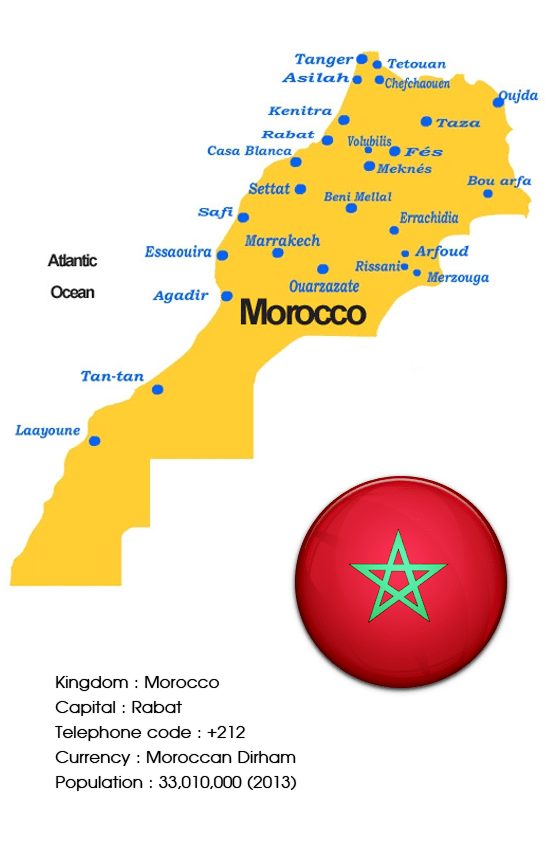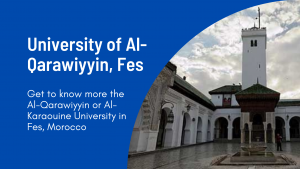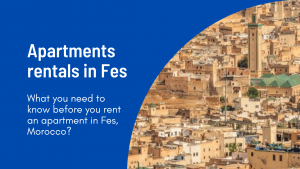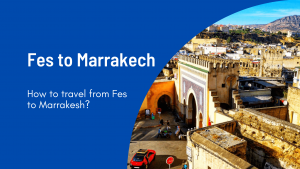Morocco is a North African country that has a coastline on both the North Atlantic Ocean and the Mediterranean Sea. Morocco has borders with Algeria, Algeria to the east, and the Spanish North African territories of Ceuta and Melilla on the Mediterranean coast in the north. It is just across the Strait of Gibraltar.

Ethnically speaking, Morocco is composed mainly of Arabs and Berbers or a mixture of the two. Sizeable numbers of Berbers live mainly in the country’s mountainous regions, long areas of refuge where they have preserved their language and culture. Some segments of the population are descendants of refugees from Spain and Portugal who fled from the Reconquista, the Christian reconquest of the Iberian Peninsula, that spanned until the 15th century.
Morocco’s long struggle for independence from France ended in 1956. The internationalized city of Tangier was turned over to the new country that same year. Morocco annexed much of Western Sahara, a former territory of Spain, in 1975.
Gradual political reforms in the 1990s resulted in the establishment of a bicameral legislature in 1997, although the King still possesses actual political power. The press is mostly state-controlled, even though there are free newspapers, and clampdowns have occurred following criticism of the authorities or articles concerning the Western Sahara situation.
The foreign policy of independent Morocco has often differed from that of its Arab neighbors. Throughout the Cold War, Morocco generally sided with the Western European powers and the United States rather than with the Eastern bloc, whereas other Arab states usually chose neutral or pro-Soviet positions.
The major resources of the Moroccan economy are agriculture, phosphates, tourism, and textiles.
Critical development challenges include lingering widespread corruption and improving the education system.
1. Holidays
The biggest event on the Moroccan calendar is the month of Ramadan, during which Muslims fast during the daytime and break the fast at sunset. Most restaurants are closed for lunch (with the exception of those catering specifically to tourists) and things generally slow down. Traveling during this time is entirely possible, and the restrictions don’t apply to non-Muslims, but it’s respectful to refrain from eating, drinking, or smoking in public during the fast.
However, outside tourist “trap” areas it may be difficult to find any food all day. Surprisingly this applies even to cities like Casablanca. At the end of the month is the holiday of Eid al-Fitr, when practically everything closes for as long as a week and transport is packed as everybody heads back home. Although alcohol consumption is not prohibited for tourists during Ramadan, only a few restaurants and bars serve alcohol. In addition, alcohol can be purchased in a supermarket if a tourist shows their passport to the staff (Moroccans are not allowed to buy or consume alcohol during the holy month).
2. Moroccan Cities & Towns
- Marrakech(Marrakesh) is a perfect combination of old and new Morocco. Plan to spend at least a few days wandering the huge maze of souks and ruins in the medina. The great plaza of Djeema El Fna at dusk is not to be missed although the sheer number and concentration of tourists may be off-putting for some.
- Fes (Fez) is the former capital of Morocco and one of the oldest and largest medieval cities in the world. It was once an imperial capital and retains its extensive walls and an “old city” smaller yet similar to that of Fez. There are a number of vineyards in the area around Meknes.
- Merzouga: a small town located in the southeast at the edge of the Erg Chebbi Dunes and the Sahara, ride a camel or 4×4 into the desert for a night (or a week) among the dunes and under the stars.
- Rabat: The capital of Morocco; very relaxed and hassle-free, highlights include a 12th-century tower and minaret.
- Casablanca: This modern city by the sea is a starting point for visitors flying into the country. If you have the time, both the historical medina and the contemporary mosque (the third-largest in the world) are well worth an afternoon.
- Agadir is best known for its beaches. The town is a nice example of modern Morocco, with less emphasis on history and culture. Take the local bus for MAD5/10 to the northern town of Auorir and Tamri where there are great beaches.
- Chefchaouen – A mountain town just inland from Tangier full of white-washed winding alleys, blue doors, and olive trees, Chefchaouen is clean as a postcard and a welcome escape from Tangier, evoking the feeling of a Greek island.
- Essaouira – An ancient seaside town newly rediscovered by tourists. From mid-June to August the beaches are packed but any other time and you’ll be the only person there. Good music and great people. Nearest Coast from Marrakech to High Atlas.
- Meknes: A laid-back city that offers a welcome break from the tourist crush of neighboring.
- Ouarzazate: Considered the Capital of the South, Ouarzazate is a great example of preservation and tourism that hasn’t destroyed the feel of a fantastic and ancient city.
- Tangier: is the starting point for most visitors arriving by ferry from Spain. An enigmatic charm that has historically attracted numerous artists (Matisse), musicians (Hendrix), politicians (Churchill), writers (Burroughs, Twain), and others (Malcolm Forbes).
- Tetouan: Nice beaches and is the gateway to the Rif Mountains.
- Al Hoceima: Beach town on the Mediterranean coast.
- Taroudannt: A southern market town.
- Laayoune: one of Morocco’s Sahara cities, knows about its seafood and considering as the capital of Sardines in the world.
- Dakhla: one of the best cities in Morocco western Sahara knows about its seafood and its seas and beaches, it knows also about surf.
- Zagora: a small city and the second famous desert in Morocco after the Merzouga Sahara. A comparison between these two famous deserts is detailed in this article: Merzouga or Zagora – The best dessert in Morocco.
- Tinghir: This town is the perfect point of access to the stunning High Atlas.
- Imouzzar: a traditional Berber town perched in the Atlas mountains, beautiful scenery, and a wonderful waterfall. Excellent handicrafts, argan oil, and Berber jewelry.
Check out more about the best places to visit in Morocco.
Foods to try in Morocco
Sample the aromatic and spicy food of North Africa by taking a trip to Morocco, a vibrant country with strong traditions and a diverse landscape of bustling cities, mountain ranges, and arid deserts.
One of the great cuisines of the world, Moroccan cooking abounds with subtle spices and intriguing flavor combinations. Think tart green olives paired with chopped preserved lemon rind stirred into a tagine of tender chicken, the surprise of rich pigeon meat pie dusted with cinnamon and icing sugar, or sardines coated with a flavourful combination of coriander, parsley, cumin, and a hint of chili. Influenced by Andalusian Spain, Arabia, and France, Morocco’s cuisine is a delicious combination of mouthwatering flavors that make it unique.



